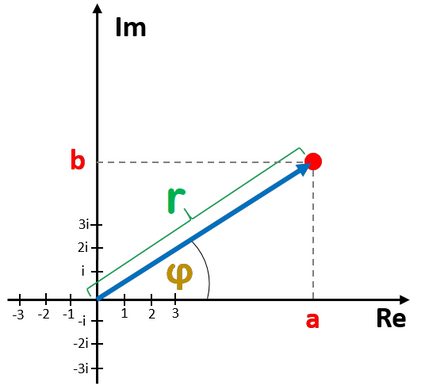Polar Form Calculator
Omni's polar form calculator can help whenever you want to convert a complex number from rectangular to polar form. Scroll down to find a short article explaining what the different forms of a complex number are all about and what the polar form conversion formulas look like. Believe it or not, converting to polar form can be fun!
What are the forms of a complex number?
The two main forms of a complex number are polar and rectangular. Usually, you first encounter the rectangular form z = a + bi, where a and b are the real part and imaginary part of z, respectively. They are both real numbers!
The polar form describes z by r × exp(φi), where:
- The magnitude
ris the distance from the origin(0,0)toz; and - The argument
φis the angle between the real axis (x-axis) and the radius connecting the origin(0,0)andz.
Look at the picture to better understand what the polar form is:

How do I convert from rectangular to polar form?
To convert a complex number from the rectangular a + bi to polar form z, we use the formulas:
r = √(a² + b²)
and
φ = atan2(b, a).
If a > 0, then atan2(b, a) = arctan(b / a). However, if a < 0, then atan(b /a) does not give us the correct angle - it must be corrected by ±π to send us into the correct quadrant of the plane. Formally atan2(b, a) is defined as:
atan(b / a)ifa > 0;atan(b / a) + πifa < 0 ≤ b;atan(b / a) - πifa,b < 0;π/2ifa = 0 < b;-π/2ifb < 0 = a; and- remains undefined if
x = y = 0.
These are exactly the formulas behind Omni's polar form converter.
How to use this polar form calculator?
To use this polar form converter, take a complex number in the rectangular form a + bi and input a and b into the respective fields of our tool. The two ingredients of the polar form will appear immediately in their fields: the magnitude r and phase (argument) φ. Take them and write down the polar form r × exp(iφ) of your number.
This can't get any easier!
Omni tools for complex numbers
Complex numbers can find you in sooo many areas of science! Omni is well aware of that - we have built a whole collection of tools addressing different problems related to complex numbers. Make sure to check out at least a few of the following tools:
- Complex number calculator;
- a+bi form calculator;
- Multiply complex numbers calculator;
- Divide complex numbers calculator;
- Imaginary number calculator;
- Complex number to polar form calculator;
- Complex number to trigonometric form calculator;
- Complex number to rectangular form calculator; and
- i calculator.
FAQs
How do I convert from trigonometric to polar form?
To convert a complex number from trigonometric to polar form, you need to:
- Make sure your number is written as
z = r × cos(φ) + r × i × sin(φ)]. - Extract the magnitude
rand the argumentφ. - Write down your number as
r × exp(φi). - If in doubt, use an online polar form calculator.
What is the polar form of -1?
The answer is exp(πi). To derive this answer, observe that the modulus (magnitude) of -1 is equal to 1. Next, we must determine φ such that cos(φ) = -1 and sin(φ) = 0. We easily verify that φ = π satisfies these conditions. Hence, the whole number reads 1 × exp(πi), as claimed.